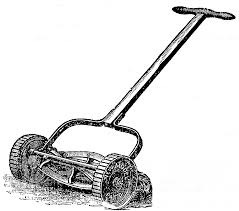OrdinaryTimes 1.42-Mow-Ring

My nephew bought this beauty at a junk shop for a buck and bestowed it on me as a wedding present in 2002. It might qualify as the finest present I’ve ever received. I didn’t sharpen it for the first decade I owned it, not that this ever affected the fine results it produced. It’s a five blade model. It leaves lawn looking as if some manicure scissor-wielding maniac took after the grass. I’ve seen some powered eight blade babies used for putting green trimming, but I’ve never seen a domestic push mower that could produce the trim this one yields.
Push mowers are not an art form, like fine camel hair brushes are not an art form, but using them can produce art. The mower only contributes to the result. The better quality the contribution, the better the result, given a caveat or two. First, one cannot mow with a push mower like one mows with a rotary power mower. The power mower just bulls through its task, breaking off the grass rather than delicately slicing it. Second, rotary power mowers suck, in that they create a vacuum which pulls the grass upward where it’s summarily guillotined. Push mowing more closely resembles combing the grass than beheading it. The technique is all in the wrist.
I keep my blades set plenty close to the cutting bar, but not so close that I’m creating undo friction when I push. The act of mowing might be fairly judged as light exercise, producing a pleasant glow rather than a full streaming sweat. I must pay attention. I dare not assume that just because I ran over something I’ve trimmed it. A lot depends upon the angle of approach and the angle of the individual grass blades. I mow in lines, up and back, twice if you insist I admit it, once up, then back over the same path. This usually produces the desired results, and if I wasn’t so picky, once over would satisfy me. There are always a few blades that grew at just obtuse enough an angle to escape pruning, but up then back minimizes these.
Edges can be problematic, or problem-manual. I might have to approach these at a forty-five degree angle, short in and out bursts, all along the edge, until I’ve properly trained the lawn. It might take a mowing or three to persuade a virgin lawn to grow right, but properly employed, a push mower will train its lawn; they synch up after only a couple of cuttings. After that, the lawn seems to eagerly submit to the weekly whacking.
When I say the proper technique is all in the wrists, I mean that much of the mowing occurs in short targeted bursts, eyes scanning critically all the time. A missed blade might get a second run at it, or even a third, before I blithely but attentively continue along my imaginary line. I used to always vary, week to week, the angle of attack. If I went up and down one week, I’d run across and back the next, but my current lawn isn’t nearly large enough for such delicacies.
I never catch the grass, understanding that anything so finely cut will be welcomed and pulled down in the ground by the worms, which will fruitfully multiple and naturally aerate the lawn as a result. When finished, the lawn looks painted on, closely cropped and rich. I might, every month or so, clean up the edges with an electric trimmer. I spend more time refilling the line feed than actually trimming. In between electric trims, the edges grow increasingly ragged, like a hipster cut hanging a bit too long over the ears.
Most important, the mower provides a sort of medium for attentive meditation. It whispers rather than roars through its chores, annoying no neighbor and allowing me to listen to some podcast if I’m not in a reflective mood. I complete my ‘chore’ refreshed, the presumed envy of every green-eyed neighbor. I blithely flip the handle over the blades and nudge my beauty down the step into its dark basement corner where it will not smell of petroleum or beg me to scrape blasted grass gunk from beneath it. I will have achieved a small communion by then, enough to sustain me for another week or so, until me and my beauty move out to mow again. Mowing is a never-ending job, an eternal responsibility. Might as well make it into art rather than chore.
©2013 by David A. Schmaltz - all rights reserved


